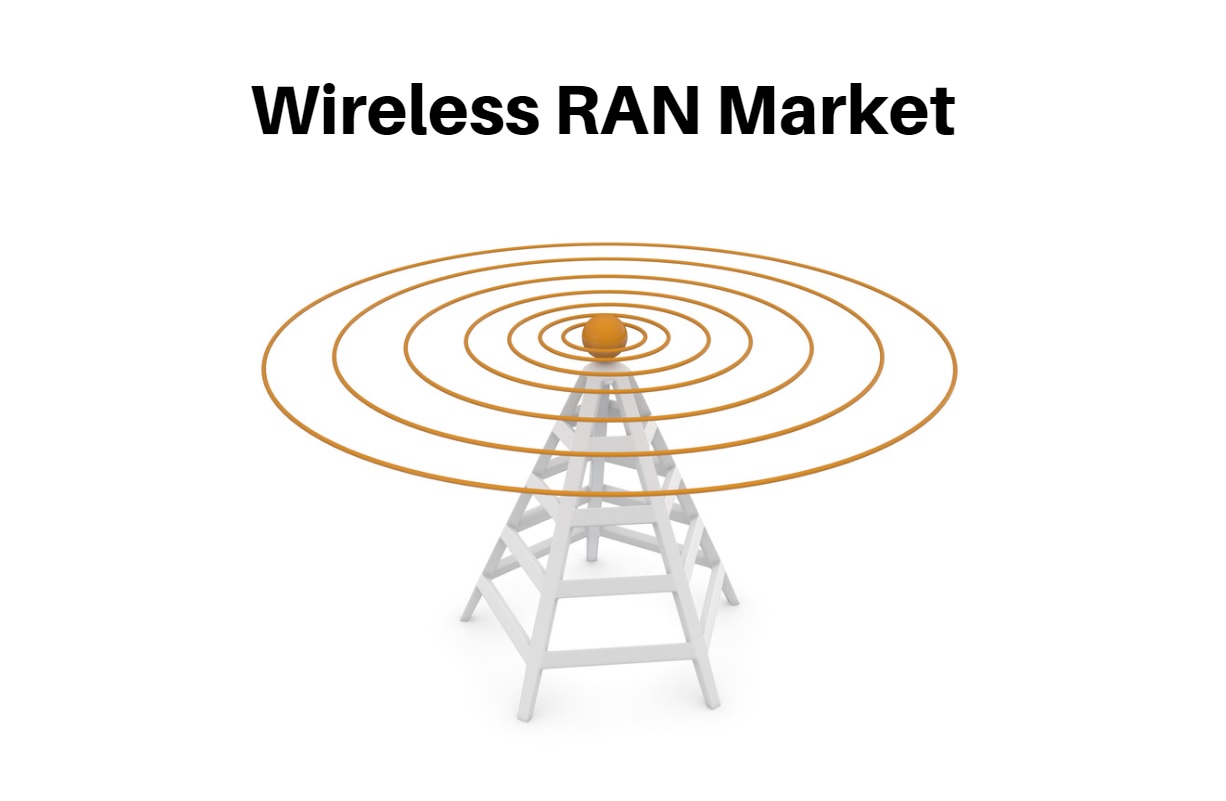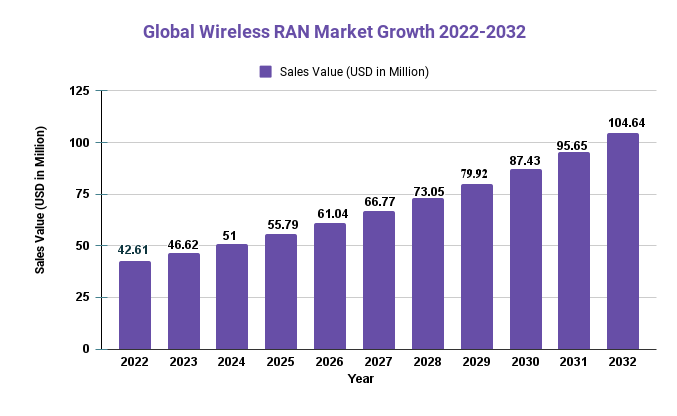Wireless RAN Market Will Hit USD 104.64 Billion by 2032

Page Contents
Published Via 11Press: In 2022, the global Wireless RAN market size was valued at USD 42.61 billion and projected to reach a value of 104.64 billion by 2032 – growing at an annual compound growth rate (CAGR) of 9.4% during 2022-2032.
The Wireless Radio Access Network (RAN) market refers to the infrastructure utilized by mobile network operators to offer wireless communication services to end-users. It consists of equipment and services necessary for communication over radio frequencies, such as base stations, antennas, and other hardware and software components.
In recent years, the market for Wireless RAN has experienced tremendous growth due to an increasing adoption of smartphones and other mobile devices, the rise of mobile data services, and demand for high-speed and dependable wireless connections. Furthermore, 5G technology is expected to further fuel this expansion within the Wireless RAN space.
Request For Sample Report Here: https://market.us/report/wireless-ran-market/request-sample
Key Takeaway
- The market for wireless RAN is fueled by factors such as the rising use of smartphones and other mobile devices, the expansion of mobile data services, and the need for fast and dependable wireless connectivity.
- With a predicted CAGR of 9.4% throughout the course of the forecast period, the market is anticipated to experience considerable expansion in the upcoming years (2021-2026).
- Because to the widespread use of mobile devices and the rising demand for fast and dependable wireless connectivity, North America and Asia-Pacific are anticipated to have the largest wireless RAN markets.
- Hardware, software, and services make up the major market components, while 2G, 3G, 4G, and 5G make up the major technologies. The market may be divided into segments based on type, and application.

Regional Snapshot
- North America: North America is projected to be one of the leading markets for Wireless RAN, due to the high adoption rate of mobile devices and increasing demand for fast and dependable connectivity. The region already has an established telecommunications infrastructure, while 5G technology is set to further fuel growth in this market.
- Europe: Europe is an important market for Wireless RAN, boasting a robust telecoms infrastructure and high mobile device penetration rates. Furthermore, the region is investing heavily in 5G technology rollout which is expected to further fuel growth within this space.
- Asia-Pacific: Asia-Pacific is expected to be the leading market for Wireless RAN, due to the high adoption rate of mobile devices and increasing need for high-speed, dependable wireless connections in countries like China and India. Furthermore, this region is investing heavily in 5G technology rollout which is anticipated to further fuel growth within this market.
- Latin America: Because to the rising use of mobile devices and the need for fast and dependable wireless communication, Latin America is a market for Wireless RAN that is expanding. The region is also making investments in the introduction of 5G technology, which is anticipated to spur market expansion.
- Middle East and Africa: As the use of mobile devices rises and there is an increased need for dependable, high-speed wireless access, the Middle East and Africa region is likewise a rising market for Wireless RAN. The region is also making investments in the introduction of 5G technology, which is anticipated to spur market expansion.
Drivers
- Increased Demand for Fast and Reliable Mobile Data: As more consumers rely on smartphones and other mobile devices for data-intensive activities such as video streaming, online gaming, and social media sharing, fast wireless connections are becoming more critical than ever before.
- Emergence of 5G Networks: The deployment of 5G networks is driving growth in the Wireless RAN market. 5G provides higher bandwidth, lower latency and faster speeds that will enable new use cases such as autonomous vehicles, augmented/virtual reality experiences and smart cities.
- Internet of Things (IoT): The demand for Wireless RAN solutions is also being fueled by the growing use of IoT devices. Wireless networks offer an affordable and flexible answer for IoT devices' need for dependable and secure connectivity to transmit data.
- Software-defined networks (SDN) and network function virtualization (NFV) are being implemented in Wireless RANs thanks to the utilisation of cloud computing and virtualization technologies. As a result, expenses are decreased, scalability is increased, and network performance is enhanced.
- Growing Mobile Workforce: The growing trend of remote working and mobile workforce is also driving the demand for Wireless RAN solutions. As more people work from home or on the go, they need reliable and fast connectivity to access business applications and communicate with colleagues.
Restraints
- High Deployment Costs: Deploying Wireless RAN solutions can be expensive, especially in rural or remote areas that require additional infrastructure. The high costs of deployment may prove a major deterrent for small and mid-sized businesses as well as emerging markets.
- Spectrum Availability: Spectrum availability is a crucial factor when it comes to the deployment of wireless networks. Spectrum scarcity can restrict the number of available wireless networks in an area, leading to higher costs and inferior service quality.
- Security Issues: Both consumers and providers of Wireless RAN are gravely concerned about the rise in cyberattacks and security lapses. The importance of safe and dependable networks increases as wireless networks become more vital to company operations.
- Government Regulations: Governments may enact rules limiting the use and expansion of Wireless RAN technology. For instance, regulatory organisations might place restrictions on the amount of spectrum that wireless networks can use or on the placement of infrastructure in particular locations.
- Competition from Wired Networks: Wireless networks offer many advantages over wired networks, but wired can still provide more dependable and consistent connectivity in certain situations. Furthermore, wired networks possess established infrastructure which makes it difficult for wireless networks to compete in certain markets.
Opportunities
- Emerging Technologies: The growth of emerging technologies such as 5G, IoT and Edge Computing presents significant opportunities for the Wireless RAN market. To support these advancements, wireless networks that offer high speed and reliability must be installed – something which can be provided by Wireless RAN solutions.
- Digital Transformation: The digital transformation of industries such as healthcare, finance and retail is necessitating the need for fast and dependable wireless networks. Wireless RAN solutions can offer the connectivity necessary to support this transformation while improving business operations.
- Smart Cities: The development of smart cities offers the wireless RAN industry yet another big opportunity. To connect different applications in these smart cities, such as traffic control systems, public safety systems, and environmental monitoring equipment, wireless networks can be used.
- Rural Broadband: Wireless RAN systems can deliver high-speed broadband Internet to remote and rural locations, bridging the digital divide and enabling access to crucial services like healthcare and education. This has a huge potential to raise living standards all over America.
- Network automation: Using automation technologies like machine learning and artificial intelligence (AI) can assist streamline and automate network operations. Costs can be brought down, network performance can be increased, and customer satisfaction can be raised.
Challenges
- Network Congestion: As the demand for mobile data continues to grow, network congestion can be a significant challenge for Wireless RAN providers. This can lead to slower speeds, reduced network performance, and customer dissatisfaction.
- Interference: Interference from other wireless networks, physical obstacles, and environmental factors can impact the performance and reliability of Wireless RAN solutions. This can be especially problematic in urban environments or areas with high population density.
- Spectrum Availability: Spectrum scarcity can hinder the growth and adoption of Wireless RAN solutions. Limited spectrum availability could lead to higher costs, reduced service quality, and limited coverage.
- Security Concerns: Security of wireless networks is a paramount concern for Wireless RAN providers and consumers alike. As these networks become more essential to business operations and everyday life, the need for secure, dependable networks grows increasingly urgent.
- Infrastructure Deployment: Deploying infrastructure for Wireless RAN solutions can be a major undertaking, particularly in rural or remote locations that require additional support. The high costs associated with infrastructure deployment may prove prohibitive to small or mid-sized businesses as well as emerging markets.
Recent Developments
- Edge Computing: Edge computing, or near-field processing of data, is becoming more crucial for Wireless RAN solutions. Edge computing helps reduce latency and enhance network performance – essential features in applications such as autonomous vehicles and industrial IoT.
- Open RAN: Open RAN is a revolutionary approach to wireless networks that utilizes open standards and interfaces for interoperability between different vendors' equipment. This trend has gained steam recently, with several major wireless carriers such as Verizon and AT&T announcing plans to deploy Open RAN networks.
Inquire Before Buying This Report Here: https://market.us/report/wireless-ran-market/#inquiry
Key Market Segments
Type
- Broadcast Radio
- Cellular Radio
Application
- Healthcare
- Automotive
- Consumer Electronics
- Defence
- Industries
Key Market Players
- AT&T Mobility LLC
- Athena Wireless Communications INC
- Azcom Technology s.r.l
- Autelan Technology International Limited
- Avago Technologies
- Aviat Networks
- AVM GmbH
- Axell Wireless ltd
- BandwidthX#Inc
- China United network communications group co.ltd
- Celtro communication Ltd
- Cisco Systems Inc
- Ceragon Networks Ltd
- Kpn International
- NTT Docomo#Inc
- Nokia Corporation
- Nomadix#Inc
- Red Hat#Inc
- Redline Communications
- Reverb Networks Inc
Report Scope
| Report Attribute | Details |
| The market size value in 2022 | USD 42.61 Bn |
| Revenue forecast by 2032 | USD 104.64 Bn |
| Growth Rate | CAGR Of 9.4% |
| Regions Covered | North America, Europe, Asia Pacific, Latin America, and Middle East & Africa, and Rest of the World |
| Historical Years | 2017-2022 |
| Base Year | 2022 |
| Estimated Year | 2023 |
| Short-Term Projection Year | 2028 |
| Long-Term Projected Year | 2032 |
Contact us
Contact Person: Mr. Lawrence John
Market.us (Powered By Prudour Pvt. Ltd.)
Tel: +1 718 618 4351
Send Email: [email protected]
FAQ.
The current market size for the Wireless RAN market is estimated to be around USD 42.61 billion in 2022, according to a report by Market.us. The market is expected to grow at a CAGR of 9.4% from 2022 to 2032.
Some of the key players in the Wireless RAN market include AT&T Mobility LLCm Athena Wireless Communications INC, Azcom Technology s.r.l, Autelan Technology International Limited, Avago Technologies, Aviat Networks, AVM GmbH, Axell Wireless ltd, BandwidthX#Inc, China United network communications group co.ltd, Celtro communication Ltd, Cisco Systems Inc, Ceragon Networks Ltd, Kpn International, NTT Docomo#Inc, Nokia Corporation, Nomadix#Inc, Red Hat#Inc, Redline Communications and Reverb Networks Inc.
The Wireless RAN market can be segmented based on type, Application. Based on Type, the market can be segmented into Broadcast Radio, Cellular Radio, Based on Application, the market can be segmented into Healthcare, Automotive, Consumer Electronics and Defence, Industries.
The team behind market.us, marketresearch.biz, market.biz and more. Our purpose is to keep our customers ahead of the game with regard to the markets. They may fluctuate up or down, but we will help you to stay ahead of the curve in these market fluctuations. Our consistent growth and ability to deliver in-depth analyses and market insight has engaged genuine market players. They have faith in us to offer the data and information they require to make balanced and decisive marketing decisions.